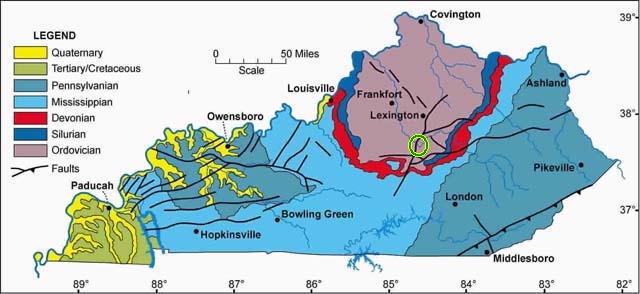**WARNING** -- This cache is only available to those traveling SOUTH on US 27. Do not attempt to cross the concrete barrier between the NORTH and SOUTH bound lanes.**
It has been brought to my attention that you MAY RECEIVE A TICKET if you park along a state highway, so please park at the listed parking coordinates.
KRS 189.450 Stopping, standing, parking, or repairing vehicle on roadway or shoulders of highway. (1) No person shall stop a vehicle, leave it standing, or cause it to stop or to be left standing upon any portion of the roadway;
*****
In the early 1970's, US Highway 27 was widened, straightened and a new bridge was built over the Kentucky River. That endeavor stripped away the cover and gave geologists a great look at the Kentucky River Fault.
Situated in the Ordovician High Bridge Group on Highway 27 just south of the Kentucky River, this structural feature includes kink folds, breccias, slickensides and mineralized fractures. Downdropped to the southeast, the fault exhibits as much as 700 feet of structural relief.
 Figure 1, several fault lines cross through Kentucky, The location in the yellow/green circle shows where the Kentucky River Fault appears just south of the Jessamine/Garrard County line.
Figure 1, several fault lines cross through Kentucky, The location in the yellow/green circle shows where the Kentucky River Fault appears just south of the Jessamine/Garrard County line.
*****
A fault is a fracture, or break, in the Earth's crust (lithosphere). This is where sections of rock move past each other. Faulting occurs when shear stress on a rock overcomes the forces which hold it together. The fracture itself is called a fault plane. When it is exposed at the Earth's surface, it may form a cliff or steep slope called a fault scarp. The angle between the fault plane and an imaginary horizontal plane is called the dip angle of the fault. Faults may dip shallowly or steeply.
Faults are categorized into three types: 1.) A normal fault is one where the fault dips toward the downthrown block. 2.) A reverse fault (if steeply dipping) or thrust fault (if shallowly dipping)[1] is a fault where the fault plane dips toward the upthrown block. Reverse and thrust faults shorten (horizontally) and thicken the crust. They are characteristic of collision origins. 3.) A transform (oceanic) or strike-slip (continental) fault is one where the relative motion is horizontal. The fault plane is usually vertical and can be horizontal.

Figure 2, While standing near the coordinates and facing the SW, you should see the rock wall leaning away and downward to your right.
 Figure 3, While standing at the coordinates you should be able to look to the NE and see where US 27 bisects the fault. Beyond that, you look across the US 27 at the structure of the road cut and see the vertical wall on the north side of the fault and the downward pitch of the wall south of the fault.
Figure 3, While standing at the coordinates you should be able to look to the NE and see where US 27 bisects the fault. Beyond that, you look across the US 27 at the structure of the road cut and see the vertical wall on the north side of the fault and the downward pitch of the wall south of the fault.
*****

Figure 4, This photo is similar to Figure 3 except the fault is more southerly on the SW side due to its SW to NE orientation.
*****
I have used sources available to me by using google search to get information for this earth cache. I am by no means a geologist. I use many types of media and ask questions about geology just like most geocachers who create Earthcaches
I think Earthcaches are cool and they cause you to slow down a bit and think. I hope you will enjoy my experience too.
*****
A PHOTO IS NOT NECESSARY to receive credit for this Earthcache, BUT, I do like them. It enables me to get a perspective of what you liked about it.
~~~If you do take pictures, PLEASE DO NOT include spoilers. ~~~
*****

In staying with the idea that EC's must be educational. Go ahead and log the cache, but immediately email me the answers to the following questions. If your answers are incorrect, I will notify you and give you the chance to correct them before deleting your log.
All answers are obtainable within the text or at the location.
1) How tall is the slanted rock face at the additional coordinates marked "height"?
2) What type of the 3 faults mentioned does this appear to be?
3) What geographical time period is associated with this fault?
4) There are 2 areas on the rock face between the parking coordinates and the fault coordinates marked with florescent paint where some holes are drilled. Add the total of holes in the two groups and email me the total along with why you think the holes were drilled.
 Bronze
Bronze Silver
Silver Gold
Gold Platinum
Platinum
